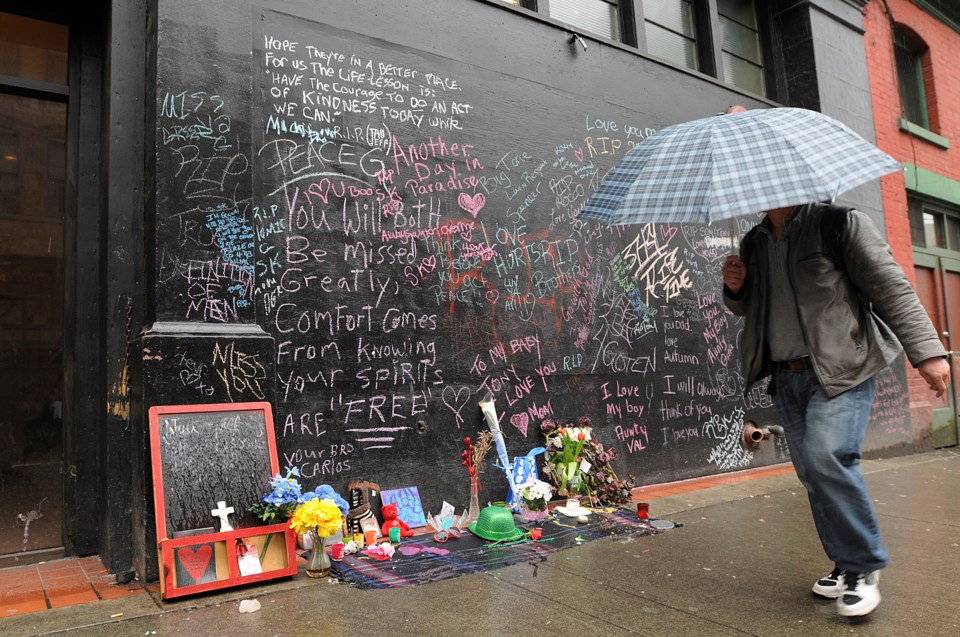The trend was too good to be true for homicide investigators: Three consecutive years where the number of murders in Vancouver never reached double digits.
As of Tuesday, police were going into the last month of this year having investigated 14 homicides, which is higher than the nine last year, six the previous year and eight in 2012.
But as Sgt. Dale Weidman, a senior homicide investigator, told the Vancouver Police Board last week and elaborated on in an interview with the Courier, the public should not be alarmed by the spike in killings.
“It looks maybe a little bit more alarming on the graph but there’s no reason to believe or any evidence to believe that we’re seeing an upward trend,” said Weidman, noting homicides across the country have steadily dropped for several years, from 611 in 2008 to 516 in 2014. Homicide rates in 2013 and 2014 were the lowest in Canada since 1966.
That’s quite a turnaround from the 1990s, when Vancouver investigators dealt with 276 murders from 1990 to 1999, many of which were connected to gang violence. For the better part of the past decade, police have watched the homicide rate plummet and attribute that to a combination of coordinated law enforcement projects targeting the drug trade, disrupting gangs and putting violent criminals in jail, Weidman said.
In fact, Vancouver’s worst year for homicides in the past eight years was in 2008 when 20 people were murdered. Police have also noticed a decline in husband-wife, boyfriend-girlfriend homicides, although Daniel Alphonse Paul was charged with second degree murder this year in connection with the death of his 36-year-old girlfriend, Crystal Rose Paul, whose body was found March 3 in the basement suite of a home on East 22nd Avenue, near Main Street.
The victim and the suspect are both aboriginal, a heritage that was examined for the first time in a Statistics Canada report released last week that showed almost one-quarter of homicide victims in 2014 were aboriginal. Of the 88 people murdered in B.C. last year, 14 were aboriginal and nine of the accused were aboriginal.
Despite the findings, Weidman said his review of Vancouver’s past homicides shows no significant trends pointing to a greater number of aboriginal people being murdered or charged with murder.
The Statistics Canada report, “Homicide in Canada 2014”, said the overrepresentation of aboriginal people as homicide victims was greatest in Manitoba, where the rate was nine times higher than the rate for non-aboriginal people. This was followed by Nova Scotia, Ontario and Alberta, where the rates were six times higher, and Saskatchewan, where the rate was five times higher.
What’s been consistent across Canada is the so-called “solve rate,” where police have identified a suspect in a homicide who may or may not have been prosecuted. In Vancouver this year, investigators have a 69 per cent solve rate.
Weidman said the widespread use of video and cellphones has helped police solve murders, although he said they don’t necessarily make or break a case. But in the murder of 47-year-old Dominic Boateng that occurred Aug. 8 outside the Insite supervised drug injection site on East Hastings, the video obtained by police helped secure a charge of murder versus manslaughter, Weidman said.
Despite the advances in technology, Weidman emphasized the need for good old fashioned police work to help solve homicides. In Boateng’s murder, a witness came forward who trusted Weidman, having met him when he worked in the Downtown Eastside.
“When I worked down there, I was fair to him and treated him with respect – that’s it,” he said, repeating what he told a patrol officer who was surprised the “rough character” spoke to Weidman. “That kind of longevity, if you will, or investment in an area is really important.”
Dennis Sleightholme, 34, has been charged with second degree murder in connection with the death of Boateng, who died after being stabbed. Knives and guns were the weapons of choice in the majority of this year’s homicides.
@Howellings



